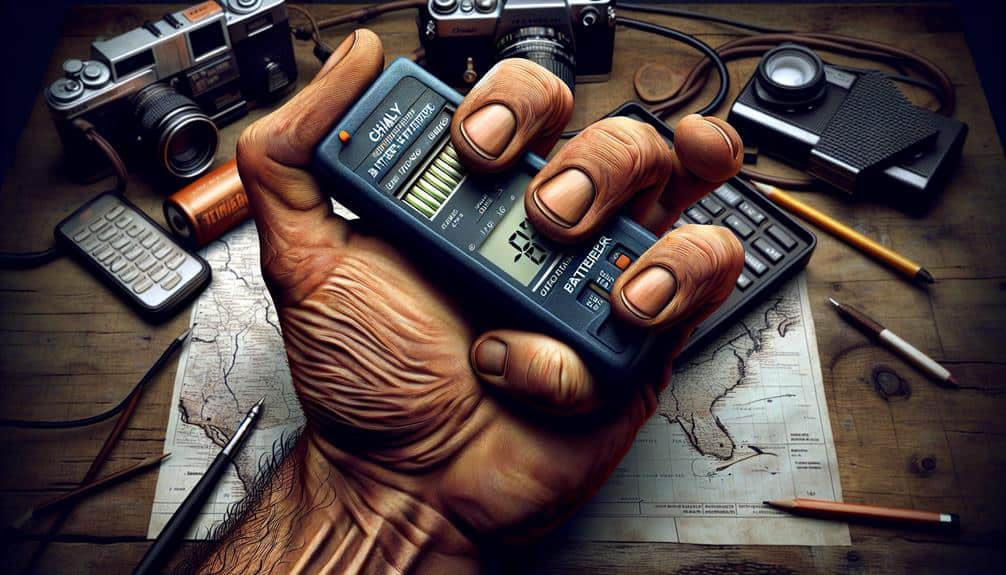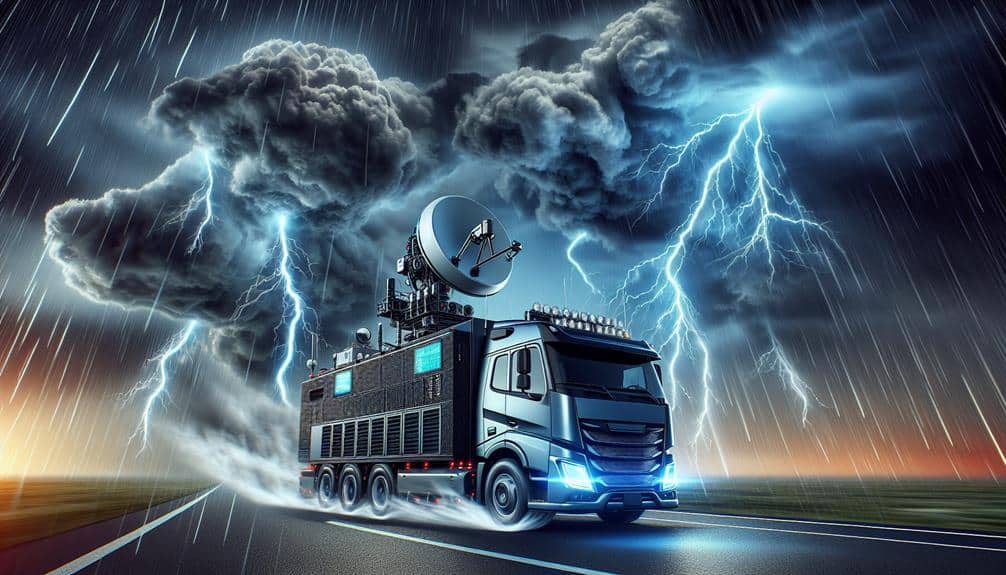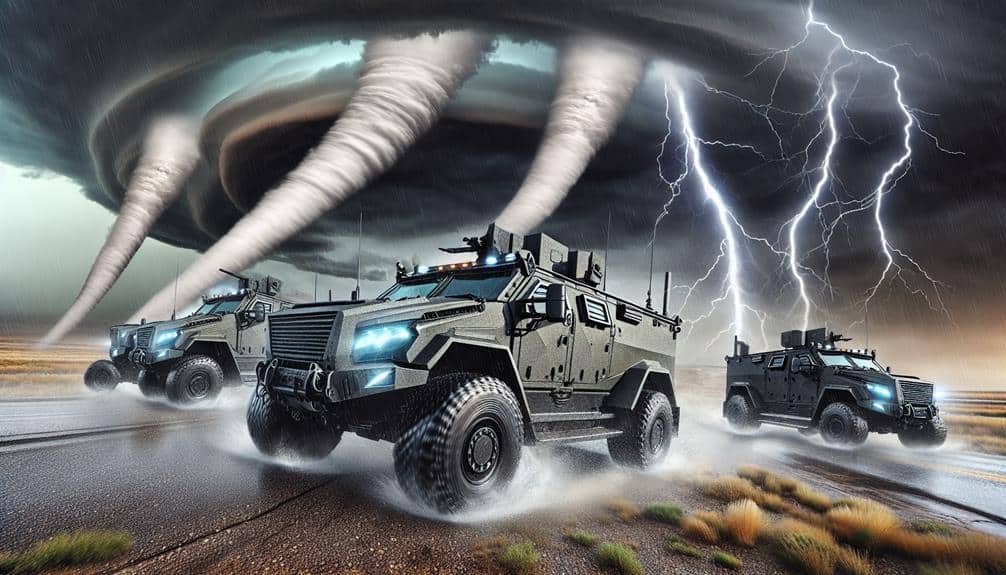We'll improve our storm chasing missions by carefully maintaining our equipment. Regularly check radar systems for antenna damage, power supply issues, and calibration needs. Clean camera lenses with attention and protect them using filters and hoods. Test GPS device signal strength and keep maps updated. It's important to update software for enhanced tracking and security. Monitor battery health and optimize charging practices to extend lifespan. Confirm mounting equipment integrity and weatherproof it to avoid damage. Balancing equipment weight helps sustain stability in challenging conditions. Staying informed about these practices guarantees we're prepared for any storm.
Key Points
- Regularly inspect and calibrate radar systems to ensure accurate data.
- Keep camera lenses clean and protected to maintain clear visuals.
- Update GPS devices and maps to ensure precise location tracking.
- Check battery health frequently and replace when capacity decreases.
Inspect Radar Systems
To ensure accurate data collection, we must regularly inspect our radar systems for any signs of wear or malfunction. Properly maintained radar systems are vital for precise weather tracking, which is fundamental in storm chasing. By adhering to a strict maintenance schedule, we can make sure that our equipment provides reliable and actionable data.
First, we should examine the radar antenna for physical damage, such as cracks or misalignment, which can greatly impair performance.
Next, we must check the system's power supply and connections to prevent any interruptions in data transmission. Any loose or corroded connections can lead to inaccurate readings.
Calibration is another important step. Regularly calibrating the radar ensures that the data we collect remains accurate and trustworthy. This process involves verifying the radar's frequency and sensitivity settings against known standards.
Additionally, software updates are essential. Keeping our radar systems' firmware up-to-date not only enhances performance but also integrates the latest advancements in weather tracking technology.
Clean Camera Lenses
Maintaining clear and unobstructed camera lenses is crucial for capturing precise visual data during storm chasing. Our ability to analyze storm behavior relies heavily on the clarity of the images we gather. To uphold peak lens performance, we must prioritize lens protection and professional cleaning.
Firstly, always use a high-quality lens filter as a barrier against dust, debris, and moisture. This simple step notably reduces the risk of lens damage. For added lens protection, consider using a lens hood, which also minimizes lens flare in bright conditions. Regular maintenance is essential; we must clean our lenses meticulously and frequently.
Professional cleaning involves using specialized tools and techniques. Begin with an air blower to remove loose particles, avoiding direct contact that may scratch the lens. Utilize a lens brush for finer debris, followed by a microfiber cloth or lens cleaning tissue with an appropriate cleaning solution. Always clean in a circular motion from the center outward to prevent streaks.
We should document cleaning intervals and techniques to ensure uniformity. Accurate visual data is crucial, and maintaining camera lenses to a professional standard underpins our storm chasing effectiveness. Let's keep our lenses pristine and our data reliable.
Test GPS Devices
Let's make sure our GPS devices are fully functional by regularly checking signal strength and updating maps. Regular diagnostics will help us maintain peak accuracy, essential for real-time navigation.
Additionally, keeping the maps current ensures we've the latest route information during storm chasing.
Check Signal Strength
We must regularly test the GPS devices to ensure maximum signal strength and accurate location tracking during storm chasing expeditions. Signal interference can greatly compromise our tracking accuracy, especially when unpredictable weather patterns come into play. To counteract this, we should conduct routine signal strength assessments under various atmospheric conditions. We need to measure the signal-to-noise ratio (SNR) and check for any anomalies that might hinder our navigation capabilities.
In instances of weak signals, integrating signal boosters can be an effective solution. These devices amplify GPS signals, thereby enhancing our tracking accuracy and ensuring we remain on course even in remote or densely clouded areas.
Additionally, by monitoring the performance metrics stored in the GPS device logs, we can identify trends in signal strength fluctuations. This data-driven approach allows us to preemptively address issues before they escalate into more substantial problems.
Moreover, we must consider the impact of environmental factors like electromagnetic interference from storm activity. By utilizing spectrum analyzers, we can pinpoint frequencies that cause disruptions and adjust our equipment settings accordingly. Maintaining ideal signal strength is essential for the success and safety of our storm chasing endeavors.
Update Maps Regularly
Consistently updating our maps ensures that our GPS devices provide the most accurate and current geographical data during storm chasing operations. This practice is crucial for effective weather tracking and guarantees we navigate complex terrains with precision.
As storm chasers, we rely heavily on real-time data; outdated maps could lead to navigational errors, jeopardizing both our mission and safety.
To achieve peak performance, we should integrate technology upgrades into our routine. Regularly downloading the latest map updates from trusted sources is essential. These updates often include new roads, changes in topography, and corrections to previous inaccuracies, which are essential for accurate positioning and route planning.
Testing our GPS devices post-update is another vital step. We must verify that all functionalities, such as satellite connectivity and route recalculations, operate seamlessly. Conducting these tests in varied weather conditions can also help us assess the reliability of our devices during actual storm chasing scenarios.
Update Software Regularly
Regularly updating software guarantees storm chasing equipment operates with the latest features, bug fixes, and security patches. This proactive approach enhances data security and shields us from cyber threats. Outdated software can leave vulnerabilities that hackers exploit, potentially compromising sensitive data and our operational integrity. By ensuring our software is current, we minimize these risks and maintain robust protection against malicious attacks.
In storm chasing, the precision of our equipment is paramount. Software updates frequently include enhancements that improve the accuracy of weather predictions and data analysis. These improvements can be vital when we're in the field, relying on real-time information to make split-second decisions. For instance, the latest algorithms in radar software can offer more precise storm tracking, giving us an edge in avoiding dangerous situations.
Moreover, regular updates ensure compatibility with new hardware and other technological advancements. Keeping our systems up-to-date means we're always leveraging the best tools available, which translates to greater efficiency and effectiveness in our operations.
Let's embrace the freedom that comes with knowing our equipment is reliable, secure, and cutting-edge. Regular software updates are a small but necessary step in achieving that peace of mind.
Check Battery Life

Monitoring battery life is vital to guarantee our storm chasing equipment remains operational in critical moments. By systematically evaluating battery levels, we make sure our devices—whether cameras, GPS units, or communication tools—do not fail when we need them most.
The first step is to establish a routine check of battery health indicators, using reliable battery management software that provides real-time data on charge cycles, current capacity, and historical performance.
Battery replacement should occur when capacity drops below 80% of the original maximum, as reduced performance can jeopardize data capture and communication. We should log each battery's performance metrics to predict when replacements will be necessary accurately.
Equally important is optimizing our charging habits. Avoiding overcharging or deep discharging extends battery longevity. Utilizing smart chargers with automatic shutoff features can help maintain ideal charge levels.
We must also consider the environmental factors; extreme temperatures can degrade battery efficiency. Storing batteries at room temperature and making sure they're not left in hot vehicles or exposed to freezing conditions will preserve their integrity.
Secure Mounting Equipment
Securing our storm chasing equipment is just as vital as maintaining battery life, as loose or unstable mounts can lead to data loss and equipment damage during high-intensity weather events.
To begin, we must focus on the integrity of our mounting brackets and fasteners. High-grade stainless steel or anodized aluminum components resist corrosion, guaranteeing long-term durability and reliability.
Proper weatherproofing equipment is essential to safeguard against the elements. We need to use gaskets and seals rated for extreme weather conditions to prevent moisture ingress. Additionally, making sure that all electrical connections are shielded with weatherproof covers will reduce the risk of short circuits.
Weight distribution plays a crucial role in maintaining stability. We must calculate the center of gravity for all mounted devices and make sure it's evenly balanced to prevent tilting or undue strain on mounting points. Using vibration-dampening mounts can reduce mechanical stress on delicate instruments when traversing rough terrain.
Frequently Asked Questions
How Do I Protect My Equipment From Extreme Weather Conditions?
We protect our equipment from extreme weather conditions using waterproof covers and protective cases. Regular maintenance routines and weatherproofing techniques guarantee peak performance. This approach guards against damage, preserving our freedom to explore and chase storms.
What Spare Parts Should I Always Carry for Storm Chasing?
We might think spare parts are unnecessary, but for emergency repairs, we should always carry essential tools like extra batteries, cables, fuses, and a multi-tool. These items guarantee our gear stays functional even in the harshest conditions.
How Often Should I Replace My Storm Chasing Gear?
We should establish a specific replacement schedule based on the equipment lifespan, factoring in maintenance costs. Regular assessments every 6-12 months help us budget effectively and maximize our gear's peak performance, offering us the freedom to pursue safely.
What Are the Best Storage Practices for Storm Chasing Equipment?
For proper storage, we should use climate-controlled environments to prevent damage. Equipment organization is critical: label containers, avoid stacking heavy items, and make sure cables are coiled correctly. Let's maximize our gear's lifespan and reliability.
How Can I Minimize Wear and Tear on My Equipment During Frequent Use?
Ever wondered how we can guarantee our equipment's durability and longevity during storm chasing? Regular maintenance, such as cleaning and timely repairs, dramatically reduces wear and tear. It's our key to maximizing operational efficiency and freedom.

